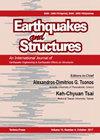通过带开口的砌体填充RC框架的现场试验验证ASCE 41评估模型
IF 1.4
4区 工程技术
Q3 ENGINEERING, CIVIL
引用次数: 1
摘要
原位推覆试验不同于振动台试验,因为它是在室外进行的,因此它的大小不受空间的限制,这使我们能够测试一个全尺寸的建筑。然而,建造一个新的全尺寸建筑进行测试是不经济的,因此世界各地的学者通常制作比例结构或全尺寸构件单元在实验室进行测试。但是,如果能够对原尺寸结构进行原位推覆试验,则可以掌握建筑物在地震中的抗震性能。鉴于此,本研究对钢筋混凝土(RC)建筑进行了两次原位推覆试验。一种是有开口的砌体填充RC建筑(砌体填充墙开口率在24% ~ 51%之间),另一种是无砌体填充的RC建筑。这两项原位推覆试验均采用即将拆除的陈旧钢筋混凝土建筑进行试验,并成功获得了该建筑的抗震能力曲线。试验结果可用于开发或验证地震评价模型。本文以ASCE 41-17为主要评价模型,并结合简化的推覆分析,可以预测台湾地区低层建筑的抗震能力曲线。有开口砌体填充的RC建筑和无砌体填充的RC建筑预测最大基底剪力值分别为试验值的69.69%和87.33%。预测的初始刚度值分别为试验值的41.04%和100.49%。可见,ASCE 41-17评价模型对于无砌体填充墙的钢筋混凝土建筑是合理的。相比之下,由于ASCE 41-17评价模型仅限于开孔率不超过40%的砌体填充墙,因此对开孔砌体填充墙的分析结果比试验值更为保守。本研究建议使用ASCE 41-17本文章由计算机程序翻译,如有差异,请以英文原文为准。
Verifying ASCE 41 the evaluation model via field tests of masonry infilled RC frames with openings
The in-situ pushover test differs from the shake-table test because it is performed outdoors and thus its size is not restricted by space, which allows us to test a full-size building. However, to build a new full-size building for the test is not economical, consequently scholars around the world usually make scale structures or full-scale component units to be tested in the laboratory. However, if in-situ pushover tests can be performed on full-size structures, then the seismic behaviors of buildings during earthquakes can be grasped. In view of this, this study conducts two in-situ pushover tests of reinforced concrete (RC) buildings. One is a masonry-infilled RC building with openings (the openings ratio of masonry infill wall is between 24% and 51%) and the other is an RC building without masonry infill. These two in-situ pushover tests adopt obsolescent RC buildings, which will be demolished, to conduct experiment and successfully obtain seismic capacity curves of the buildings. The test results are available for the development or verification of a seismic evaluation model.
This paper uses ASCE 41-17 as the main evaluation model and is accompanied by a simplified pushover analysis, which can predict the seismic capacity curves of low-rise buildings in Taiwan. The predicted maximum base shear values for masonry-infilled RC buildings with openings and for RC buildings without masonry infill are, respectively, 69.69% and 87.33% of the test values. The predicted initial stiffness values are 41.04% and 100.49% of the test values, respectively. It can be seen that the ASCE 41-17 evaluation model is reasonable for the RC building without masonry infill walls. In contrast, the analysis result for the masonry infilled RC building with openings is more conservative than the test value because the ASCE 41-17 evaluation model is limited to masonry infill walls with an openings ratio not exceeding 40%. This study suggests using ASCE 41-17
求助全文
通过发布文献求助,成功后即可免费获取论文全文。
去求助
来源期刊

Earthquakes and Structures
ENGINEERING, CIVIL-ENGINEERING, GEOLOGICAL
CiteScore
2.90
自引率
20.00%
发文量
0
审稿时长
>12 weeks
期刊介绍:
The Earthquakes and Structures, An International Journal, focuses on the effects of earthquakes on civil engineering structures. The journal will serve as a powerful repository of technical information and will provide a highimpact publication platform for the global community of researchers in the traditional, as well as emerging, subdisciplines of the broader earthquake engineering field. Specifically, some of the major topics covered by the Journal include: .. characterization of strong ground motions, .. quantification of earthquake demand and structural capacity, .. design of earthquake resistant structures and foundations, .. experimental and computational methods, .. seismic regulations and building codes, .. seismic hazard assessment, .. seismic risk mitigation, .. site effects and soil-structure interaction, .. assessment, repair and strengthening of existing structures, including historic structures and monuments, and .. emerging technologies including passive control technologies, structural monitoring systems, and cyberinfrastructure tools for seismic data management, experimental applications, early warning and response
 求助内容:
求助内容: 应助结果提醒方式:
应助结果提醒方式:


